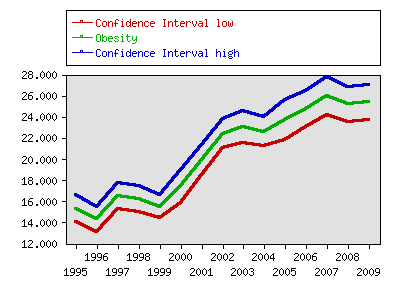Indicator 16: Obesity


Goal: Minnesotans will be healthy.
Rationale: Growing rates of obesity have become a major source of concern in public health circles. Obesity is a major risk factor for heart disease, diabetes and other ailments.
About this indicator: Obesity rates have increased substantially in Minnesota. In 1995, 15.3 percent of Minnesotans were classified as obese. By 2009 the rate was 25.4 percent. Obesity is defined as a body mass index of 30.0 or more.

For comparison: Minnesota is similar to the national average. Nationally, 26.9 percent of the population was classified as obese in 2009.
Sources:
- U.S. Centers for Disease Control and Prevention, Behavioral and Risk Factor Surveillance System, http://www.cdc.gov/brfss/
Local data:




